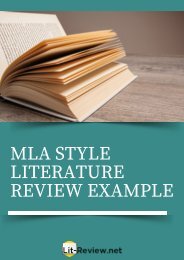Astonishing Sample Literature Review MLA Format
How to get the best astonishing sample literature review MLA format. Geth this info here http://www.lit-review.net/mla-literature-review/
How to get the best astonishing sample literature review MLA format. Geth this info here http://www.lit-review.net/mla-literature-review/
You also want an ePaper? Increase the reach of your titles
YUMPU automatically turns print PDFs into web optimized ePapers that Google loves.
LITERATURE<br />
REVIEW <strong>MLA</strong><br />
FORMAT SAMPLE
L I T E R A T U R E R E V I E W M L A F O R M A T S A M P L E<br />
STRESS AND ITS CONSEQUENCES 1<br />
The term stress, both in science and in everyday life, was so widespread that it took on a large number of<br />
meanings and forms. Many scientific disciplines have studied various aspects of stress, from biological sciences<br />
such as physiology, biochemistry and neurophysiology; through psychology with their disciplines: clinical<br />
psychology, mental hygiene, developmental psychology, social psychology, and others; to social sciences such as<br />
anthropology and sociology. It is not surprising that the notion of stress in these scientific disciplines is used in<br />
various meanings, contributing to such confusion as to its definition. However, even if the notion of stress is<br />
unclear or contradictorily defined in most cases, it nevertheless directs the attention of scientists to a number of<br />
interesting and important phenomena. The existence of a large number of different definitions can be viewed as an<br />
indicator of the significance of this term. Observed in a wider context, the fact that stress studies are performed at<br />
different levels of analysis can bring hope, not despair. Although this brings some difficulty in defining stress on<br />
the one hand, the other stress represents the point in which a large number of scientific disciplines are encountered<br />
and provides an excellent opportunity for interdisciplinary and integration. In psychological literature, as well as in<br />
formal and informal communication among experts, it can be noted that stress is most often understood in one of<br />
two ways, where within each of them there are two variants of definition. The first understanding of stress<br />
determines an event in an external environment, as follows: (1) as an event that poses a threat or loss to most<br />
people (or, less often, a challenge); or (2) as an event that constitutes a threat or loss (or challenge) for a particular<br />
individual. Another notion is that stress represents a reaction to an event in an external environment, namely: (1)<br />
the activation of intense feelings (usually unpleasant); and / or (2) a set of characteristic body reactions. The<br />
definition proposed by Lazarus & Folkman and Aldwin, representatives of the transactionalist understanding of<br />
stress, encompasses both the above-mentioned points; whereby, from the framework of the first determination of<br />
stress (as an event), a subjective assessment is particularly emphasized, due to which some events are characterized<br />
as threats, losses or challenges. This stress is the relationship between a person and the environment, within which a<br />
person estimates that some aspect of the environment includes a threat, loss or challenge for its strength, with<br />
characteristic changes in the psychophysiological balance. The threat is widely understood here. This can be an<br />
objective danger, i.e. a direct threat to life, but also a threat to other important people, for important support in life,<br />
a standard way of life, beliefs, and so on. The same applies to loss. In this context, loss means not only the death of<br />
a significant person, but can also involve a break in the relationship with a moving friend, a break in partnership, a<br />
loss of home in a refugee, and so on. Within the framework of a transactional approach, stress is stressed as a<br />
process, not an external environment or a state of the organism. The most important components of stress<br />
according to this definition are: (a) a particular event or situation in the outer environment; (b) a characteristic<br />
subjective assessment of the event; (c) changes in psychological functioning; (d) physiological changes and (e) the<br />
experience of the entire process. Among the components of stress, the transaction model emphasizes the<br />
importance of cognitive processes and individual differences in the assessment of events in the external<br />
environment. Also, it implies a special relationship between the components of stress, which is the interdependence<br />
of factors from the domain of the environment and from the domain of the person experiencing stress, as well as the<br />
variability of the above-mentioned factors under the influence of the current transaction.
L I T E R A T U R E R E V I E W M L A F O R M A T S A M P L E<br />
STRESS AND ITS CONSEQUENCES 2<br />
For stress can only be talked about when a person is exposed to an event that he / she assesses as a threat, loss<br />
or challenge, i.e. when a person estimates that the situation requires the investment of increased, extraordinary<br />
efforts to adapt. Situations or events that are subjectively assessed here are referred to as stressful events, stressful<br />
situations, or stressors. (Stress events include components a and b to the transactional stress determination.) This<br />
implies that a stressful situation involves a change in relation to the previous state; and that the duration of the<br />
stressor can be determined with a lower or higher precision, i.e. that stress situations do not include very long-<br />
lasting adverse living conditions, which may have different (adverse) effects on the psychophysiological<br />
functioning of the organism and development. Researchers in the field of stress have studied a large number of<br />
different events that can be characterized as stressful. The subject of the earliest studies is war and natural disasters.<br />
Later, studies of events involving lower intensity of threats for the exposed person began.<br />
From the point of view of Lazarus, what is stressful for one person at a particular moment in her life does not<br />
have to be stressful for another person or for the same person at some other time. Loss of work is not equally<br />
stressful for a teenager and a middle-aged man. Stress arises from a combination of conditions in the outer<br />
environment and individual characteristics that are important for resolving the current situation. Among the<br />
environmental conditions of particular importance are cultural factors that shape both the types of events that can<br />
be exposed to members of the culture, as well as the subjective assessment of events. (In different cultures, some<br />
events are considered normal, normative, which reduces their perceived stress.) According to Lazarus, a subjective<br />
assessment of the event involves assessing the degree of demand that is set before an individual, as well as the<br />
support that an individual has at his disposal in the process of dealing with the problem. According to his model, a<br />
person first recognizes that there is a problem before it (primary assessment), and then judges what capacities it<br />
needs to solve the problem (secondary assessment). Stress is the result of an assessment that there is a discrepancy<br />
between the requirements in a particular situation and the person's ability to meet these requirements.<br />
Among the changes in the psychological plane characteristic of stress, the most prominent changes in the<br />
sphere of emotional processes. Emotional reactions characteristic of stress are most commonly anxiety, anger and<br />
sorrow, and they can also show shame, guilt, overdose (dullness). After traumatic or other intense stress (associated<br />
with loss or diagnosis of incurable disease), emotional bruising may occur. Changes in psychological functioning<br />
during stress can be so intense that they take on the dimensions of the psychological crisis. Crises are turbulent and<br />
dramatic psychological conditions that call into question the entire functioning of a person, its choices, beliefs, and<br />
so on. (The beginnings of the use of this term in psychology and psychiatry are related to the establishment of<br />
suicide prevention centers, which are also known as centers for crisis intervention). The crisis always indicates a<br />
change, which is not partial, but comprehensive and essential. The crisis is most studied in the humanist-<br />
existentialist theoretical context, in which it is emphasized that the changes that have emerged after the crisis can be<br />
positive, and the personality is enriching.<br />
The state of the body during stress also involves certain physiological reactions. Although the usual<br />
assumption is that stress involves negative physiological effects, it would be more accurate to say that it implies an<br />
activating effect, which may occasionally be positive. The direction of the effect depends on a large number of<br />
personal and contextual factors.
L I T E R A T U R E R E V I E W M L A F O R M A T S A M P L E<br />
STRESS AND ITS CONSEQUENCES 3<br />
Physiological reactions within the stress of the process can be divided into two interrelated categories:<br />
neuroendocrine and immunological. The neuroendocrine category includes reactions of the autonomic nervous<br />
system (sympathetic and parasympathetic), together with reactions of the endocrine system. Observation of a stress<br />
event triggers a hypothalamus that stimulates the release of the pituitary hormone. These hormones activate the<br />
secretion of adrenaline and noradrenaline (an adrenaline hormone) that stimulates the activity of the sympathetic<br />
nervous system. When the danger stops, parasympathetic activation returns the body to the state of homeostasis by<br />
reducing blood pressure and pulse, reducing the number of breaths and restoring reduced gastrointestinal activity to<br />
the normal level. This process was described by Cannon. Selye considered that physiological response in stress, i.e.<br />
"General adaptation syndrome", takes place in three phases. The first is the alarm phase, with the changes described<br />
by Cannon. In the second phase there is an adaptation, i.e. return to physiological homeostasis. The third is a phase<br />
of exhaustion, when a disease or death occurs, if stress continues. Today, neuroendocrine changes characteristic of<br />
stress are generally known. Current dilemmas in this area are: whether there are individual differences in<br />
physiological response to stress; and whether physiological changes are specific or not, i.e. whether all the stressors<br />
are related to one general reaction or are different stressors related to different types of reactions. Cannon and<br />
Selye's model implies that physiological reactions that are part of the stress of the process are universal. Recent<br />
research, however, suggests that there are differences in the response that are the source of individual<br />
characteristics, as well as the differences that are related to different types of stressors. Disorders in the functioning<br />
of the immune system are another category of changes in the body that are characteristic of stress. They are very<br />
complex and insufficiently examined. There are data on the higher incidence of various disorders and diseases in<br />
people experiencing frequent and / or severe stress. However, it is about the data of correlation studies, which say<br />
nothing about the mechanisms of the disease and the direction of possible causality.<br />
A modern version of the old debate between James and Cannon is that between Lazarus and Zajonc, about<br />
whether the primary cognitive or emotional processes are in the context of stress. Lazarus believes that cognitive<br />
processes are central in determining whether the situation is dangerous or threatening, so cognition determines<br />
whether or not stress will occur and what emotional reactions will be (Lazarus & Folkman). Zajonc, however,<br />
indicates that simply the existence of consciousness should not be called cognition; and believes that emotional<br />
reactions characteristic of stress occur before and may be incompatible with cognitive. At the heart of this debate is<br />
the disagreement about defining emotions and cognition. Zajonc's implicit definition of cognition is very close to<br />
the definition of rational, logical thinking, while Lazarus is close to simple consciousness. It is true that a person<br />
must be aware of events before he reacts to it. However, is this awareness primarily emotional or rational? In other<br />
words, do people become angry or frightened first, then find the reason for their feelings, or they first recognize and<br />
define the situation as a threat, then react to it? Both of these questions can be given a confirmatory answer. In<br />
some situations, it first reacts emotionally, and then ponders, and in other situations, it can happen that a person<br />
does not react until he fully understands the threat posed by the situation.
L I T E R A T U R E R E V I E W M L A F O R M A T S A M P L E<br />
STRESS AND ITS CONSEQUENCES 5<br />
REFERENCES<br />
Lazarus, R. S. & Folkman, S. Stress, appraisal, and coping. New York, Springer, 1984.<br />
Lazarus, R. S. Emotion and adaptation. New York, Oxford University Press, 1991.<br />
Aldwin, C. M. Stress, coping, and development. New York, Guilford Press, 1994.<br />
Selye, H. The stress of life. New York, McGraw-Hill, 1956.<br />
Zajonc, R. B. On the primacy of affect. American Psychologist, 39, 117 - 123, 1984.<br />
Cannon, W. B. Bodily Changes in Pain, Hunger, Fear and Rage: An Account of Recent Researches into the<br />
Function of Emotional Excitement. Appleton-Century-Crofts, 1915.





